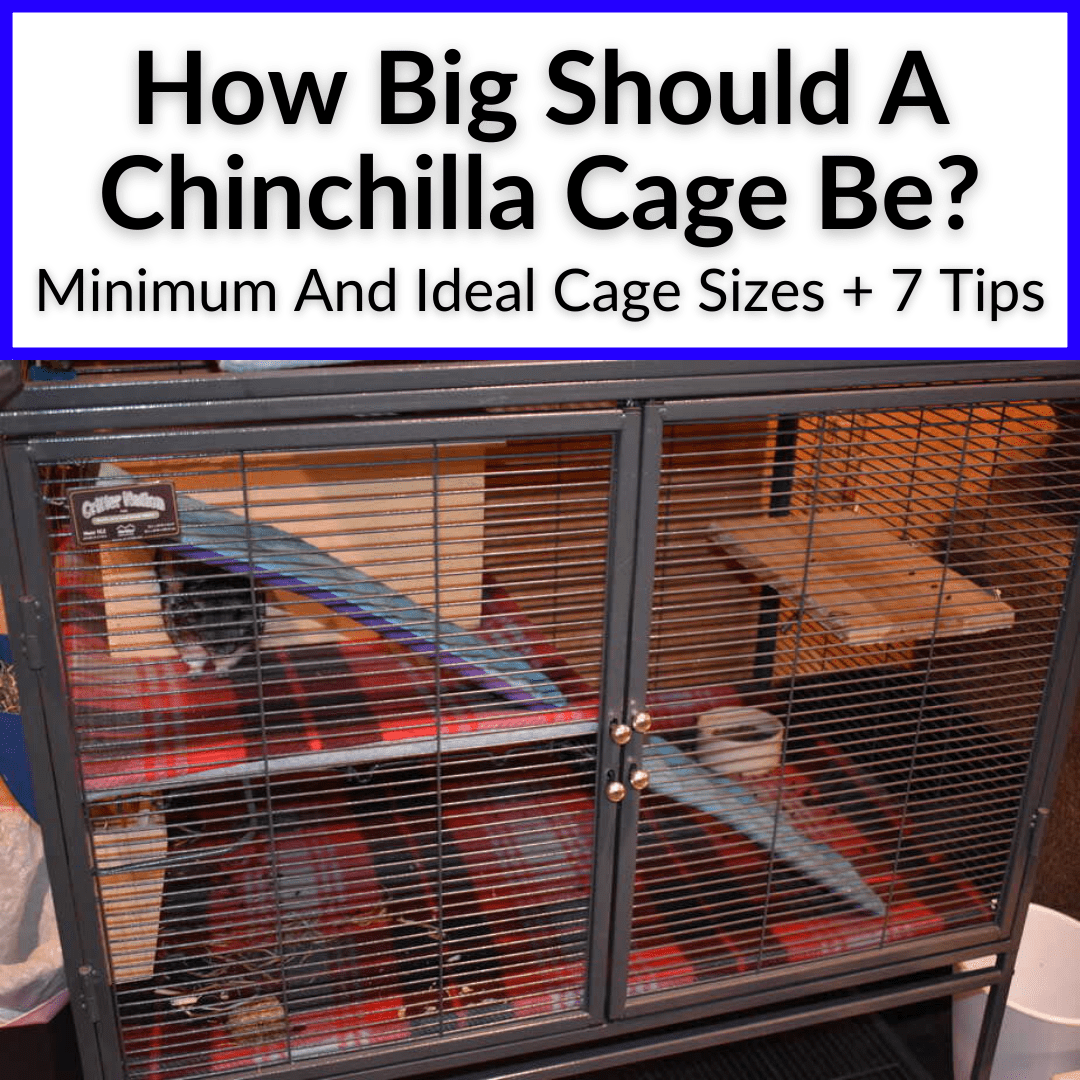
So you really don’t need a big cage, right?
Well, big is relative.
The cages you tend to see on YouTube, Instagram, TikTok, etc. are usually far too small.
Chinchillas need more space in their cage than most other similarly-sized pets.
How big should a chinchilla cage be then?
Keep reading to learn the absolute minimum dimensions for a chinchilla cage and which cage I recommend and use myself. It is probably a bit larger than you might expect.
But there is a reason chinchillas need a lot of space in their cages. And not providing it is cruel. We’ll get into all of that below.
Contents
- 1 How Big Should A Chinchilla Cage Be?
- 1.1 The Ideal Cage
- 1.2 7 Tips For Picking The Correct Sized Chinchilla Cage
- 1.2.1 #1: Understand Your Chinchilla’s Natural Abilities And Behaviors
- 1.2.2 #2: The Placement Of The Cage Matters
- 1.2.3 #3: The Inside Of The Cage Is Equally Important
- 1.2.4 #4: Don’t Forget The Necessities Inside The Cage
- 1.2.5 #5: Keep The Cage Clean
- 1.2.6 #6: Consider Noise, Commotion, And Environment
- 1.2.7 #7: Find The Perfect Blend Between Toys And Essentials In The Cage
- 1.3 Chinchillas Also Need Time Out Of The Cage
- 2 Chinchilla Cage Size: Final Thoughts
How Big Should A Chinchilla Cage Be?
Your chinchilla cage should be no smaller than 3 by 2 by 2 feet. Chinchillas need cages with plenty of vertical space, with multiple levels and ledges throughout the cage.
I have a few posts on this blog that discuss the crazy jumping and climbing abilities that chinchillas have. This is one of the primary reasons that chinchillas need as much space as possible.
I have a post completely dedicated to discussing if chinchillas need a big cage here. It will break down why chinchillas need these minimum requirements and give you a more in-depth look.
Chinchillas in the wild are used to roaming the mountains and using their natural abilities to jump and climb to keep them safe.
They are a naturally hunted animal. Not the hunter.
The ability to find a way to feel safe when they feel threatened is just the beginning part of the equation to keep your chinchilla safe and happy for years to come.
Here is a quick look at the ideal chinchilla cage that meets the sizing requirements, along with all the other requirements for a good chin home.
The Ideal Cage
I currently use the Critter Nation 2 Dual Level Cage, and I only have 1 chinchilla. She uses every level, every shelf, and every hanging item I have placed in this cage.
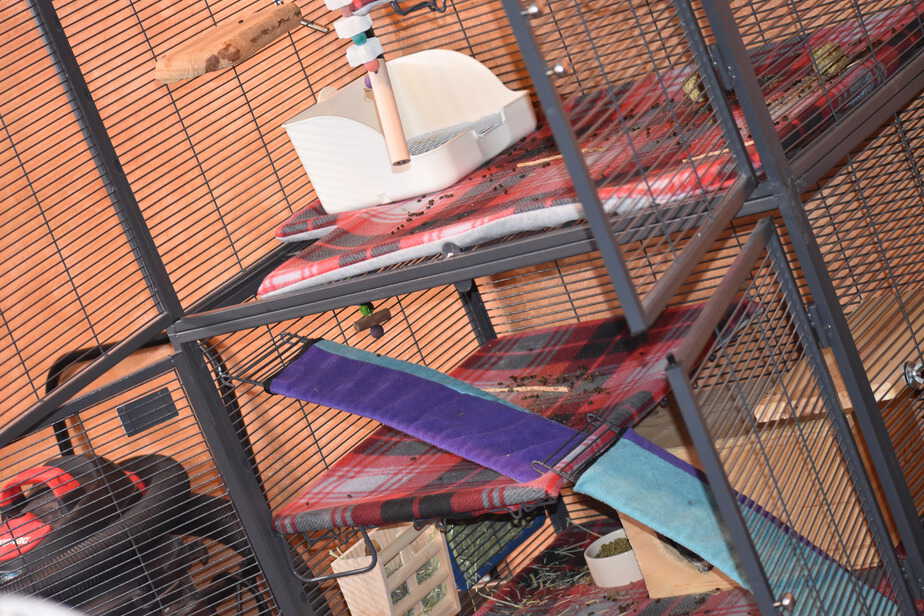
While I understand that this cage is designed to allow for a pair of chinchillas, I don’t believe you have to use that approach. In my opinion, the dimensions of the Critter Nation 2 Dual-level cage are perfect for one chinchilla.
It measures 36 inches long by 24 inches deep and 63 inches tall. It is also my top choice in my post reviewing the best chinchilla cages.
As I said, my 5-year-old female chinchilla has plenty of space and different ledges to explore and act as a chinchilla should.
Now, don’t get me wrong, I wouldn’t feel terrible about placing a second chinchilla in her cage with her, if they got along and were bonded correctly.
I personally don’t believe in going with a cage smaller than the dimensions given above.
Chinchillas simply enjoy jumping and going crazy more than most people understand. To limit their abilities in a smaller cage is not only unethical but borderline cruel.
If, however, your home doesn’t permit a cage of this size, attempt to get as close to this size as possible.
I personally believe she enjoys using the top levels, which is where I keep her potty-training litter box, a second water bottle, and her chinchilla hammock.
You can read more about the hammocks I recommend for your chinchilla cage here.
I also keep a few of her favorite items to play with on the top deck, to encourage her to move around and get up and active on the high levels.
Now that we know the basics of what size a chinchilla cage should be, let’s move into more of the fine details.
7 Tips For Picking The Correct Sized Chinchilla Cage
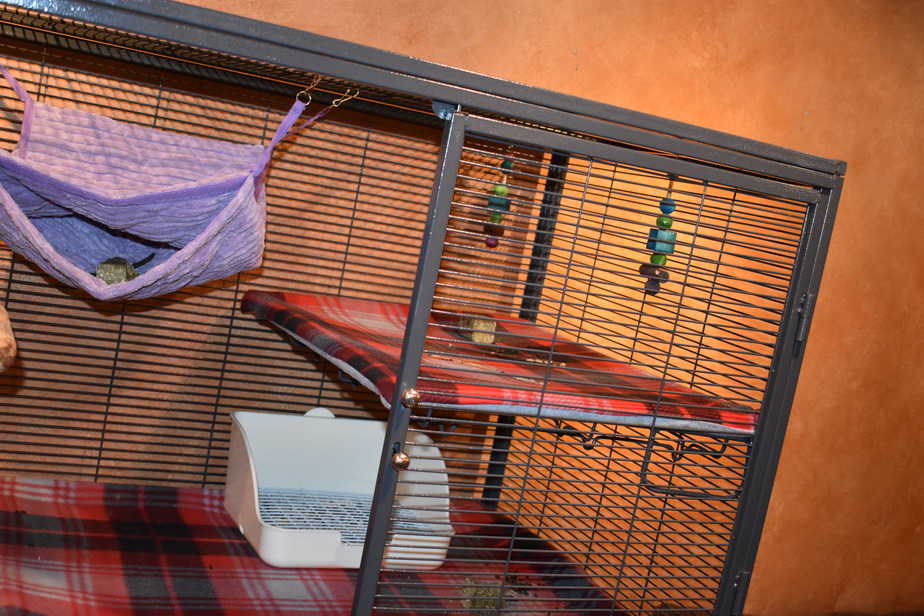
Here are 7 additional tips to help in choosing the correctly sized chinchilla cage for your new chinchilla.
#1: Understand Your Chinchilla’s Natural Abilities And Behaviors
As stated previously, it’s essential to do some preliminary research about chinchillas before adopting one. Or, at the latest, shortly after adopting one.
It’s ethical and how you ultimately provide a safe and comfortable environment. It is all part of learning how to take care of a chinchilla.
Also, as I stated before, we know these rodents love to jump and climb. Some types of chinchillas also grow bigger than you might think.
And they are high energy animals when they are awake.
Of course, this is only at certain times of the day, and most of the time, chinchillas do sleep. They are usually most awake in the mornings and evenings.
However, when they are awake, they want to chew on safe chinchilla toys and hop from ledge to ledge. They also love to interact with us as humans and grow to recognize us and love us.
It’s crucial that we understand that we can’t always afford our chinchillas time to interact with us. This is what makes it even more critical for us to provide an adequately sized cage that can keep our little pet entertained.
It’s also important to make it as fun as possible which we will touch on this later.
It’s vital that we don’t allow our chinchillas to slip into depression or become restless within their cages. Shockingly enough, this can happen quickly if we aren’t careful and don’t plan accordingly.
For this reason alone, I’m happy that you found this blog post.
It shows me that you are not only interested in creating the perfect cage and environment for your chinchilla, but that you genuinely want to ensure that your chinchilla is always happy.
Trust me, the cage alone can go a long way towards ensuring this takes place.
#2: The Placement Of The Cage Matters
While the size of your chinchilla cage matters substantially, the location of the cage matters just as much and needs careful consideration.
First and foremost, you must get the temperatures correct and always keep your chinchilla at ideal temperature.
This means that you need to select a room of the home that won’t get too hot or too cold for your chinchilla. The temperature should never exceed 75 degrees and never should drop below 50 degrees.
If it gets too hot, your chinchilla could overheat and potentially die from heatstroke, which is clearly something we are all trying to avoid.
Choose a room that doesn’t take in too much direct sunlight, and that won’t get too hot. Also, keep in mind that A/C units in the house do fail from time to time.
My point with that statement is that if you decide to leave your chinchilla alone for the weekend, you don’t want to run the risk of the A/C unit failing and causing your chinchilla to overheat.
A chinchilla’s fur is too dense, which is the primary cause of overheating. Keep an eye on your chinchilla and always be aware of this potential problem.
A sure-fire way to know if something could be wrong is to check your chinchilla’s ears.
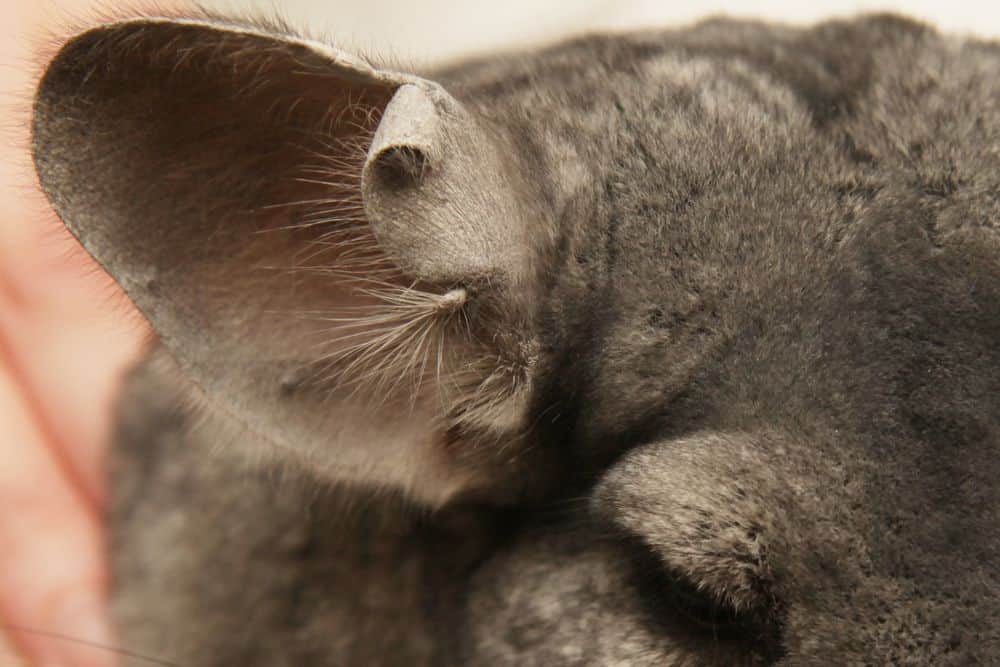
If your chinchilla’s ears are turning red or showing blood vessels, this could be an indicator that it is overheating, and you need to find a cooler spot for your pet.
Don’t worry if your room is isolated a bit. Chinchillas adapt to their environment very quickly if you give them a few days and don’t rush the process.
Lighting Is Important Too
Lighting is also essential for your chinchilla and an area of cage placement that’s often overlooked. Chinchillas are like humans with how they see in the dark.
For that reason, I prefer to keep at least one small night light on for my chinchilla when I’m done interacting with her for the day. I don’t want her in a room where she can’t see as she jumps and climbs around throughout her cage.
Not to mention the fact that I enjoy leaving her chew sticks and other items to play with, so I want her to be able to see adequately. However, I don’t want to disrupt her sleep either.
Keep in mind that chinchillas are most active when it’s dark, so it’s tough to know the perfect blend. My solution is to keep the lights on during the day, because she is in my home office in my basement.
I also leave one night-light on her for her to be able to see while I’m sleeping. It’s that easy.
While I may not know it all, I have found this to work well, and she hasn’t voiced many complaints thus far about my choices.
No barking, no squealing, and no other crazy chinchilla noises so far into my chinchilla parenting career so I will assume for now she is happy and content with the set up that I’m providing for her.
#3: The Inside Of The Cage Is Equally Important
This is another area not to get lazy with. First, as we stated before, spend the money on a good size cage. However, the journey doesn’t end here.
Now it’s time to make sure your chinchilla has additional shelves, places to jump, and plenty to do inside of the cage. I can’t stress this enough.
A big cage with only 4-5 platforms is not enough. The shelving is super easy to attach to the sidebars of the cage, and you can even cut your own wood. Simply place the shelves in random spots on different levels to give your chinchilla plenty of hopping and climbing fun.
Design The Inner Chinchilla Cage Like A Rock-Climbing Venue

I frequently change my cage-setup just to keep my chinchilla active and never getting bored. I like to picture it like a rock-climbing wall: always unique and with random jumps at different levels for her to climb.
Mix it up and give him or her plenty of space to jump safely and provide plenty of hanging toys. Your chinchilla will love you greatly in return for your efforts.
Let’s move onto tip #4, which discusses the must-haves to never forget inside of your chinchilla’s cage.
#4: Don’t Forget The Necessities Inside The Cage
Okay, some of these may seem obvious, but you would be surprised at the information I read in forums and other communities online.
First and foremost, you must make sure you have hay-feeders inside of your chinchilla’s cage. I personally use two hay-feeders in my cage. I like her to have as much as she wants, and I stick to timothy hay blends.
Additionally, you should have a bowl (glass) that has chinchilla formulated pellets. Your pet need these every day, on top of the hay.
If you aren’t quite aware of what a chinchilla eats, read my post that details all the dos and don’ts of a chinchilla’s diet.
Next, we have the obvious water bottle attachments. Be sure you have a water bottle attached to on chinchilla’s cage that is always filled with fresh water.
I personally use two water bottles, just in case I get stuck at work or accidentally do not notice a water bottle running low. I have OCD like that, and it helps me sleep at night. Judge if you want, but it’s the way I operate.
Outside of these items, you have a few others that also need space inside the cage, like hiding boxes, ramps, and chew toys. It is best to check out my post on the subject for this information.
It’s a quick read and details everything your chinchilla needs inside of its cage, from A-Z.
Now it’s time to get your hands dirty and to make sure you are keeping the cage clean for your chinchilla.
#5: Keep The Cage Clean
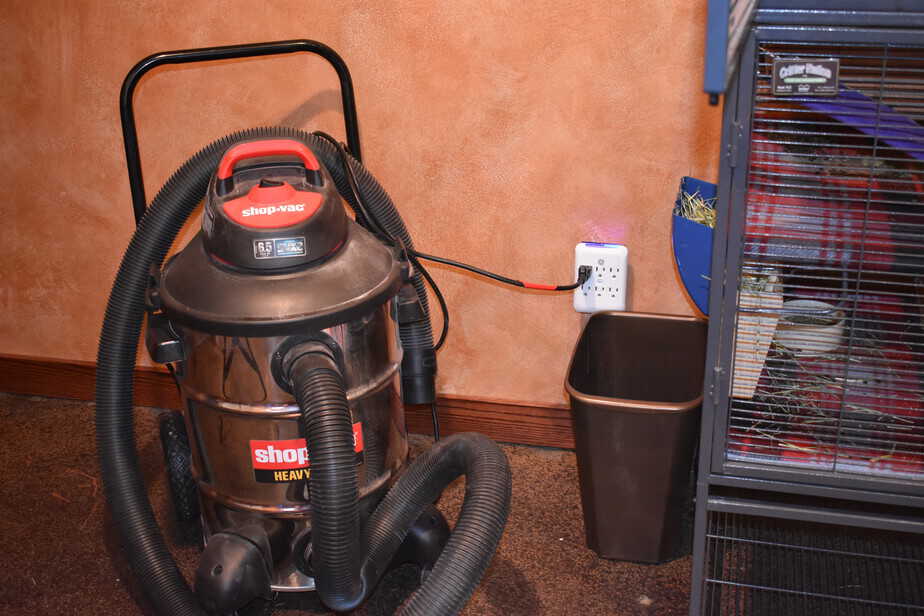
I have several posts that go into detail about how important it is to clean your chinchilla’s cage regularly. It’s a must.
While it’s great to have the size correct with a large enough cage, it’s equally essential to ensure its kept clean and free of chinchilla poop and chinchilla pee.
This is easy to do. In fact, fleece is perfectly safe for your chinchilla and a great alternative to traditional bedding, aka wood shavings.
It makes cleaning the cage that much easier. I currently use this fleece liner designed to fit the trays for the Critter Nation 2 cage I mentioned previously.
- Designed specifically for Critter Nation Cage
- Includes: Two large pan liners (one with a notch/cut-out for the ramp opening, Two small shelf liners and three ramp covers
- Available in various designs
I have two pairs and don’t think the price on Amazon is unfair by any means, for the value you get in return. Especially since they will save you money in the long run, due to no longer having to constantly buy more wood shavings.
All you need to do if you use these fleece liners is to wash them in cold water and shop vac the poop pellets out of the cage daily. Easy as 1,2,3.
Seriously, cleaning the cage is easy, and one of the reasons I think owning a chinchilla, in general, is extremely easy compared to owning other pets like rabbits.
Let’s me say that one more time in case any of you are on the fence about adopting a chinchilla.
Chinchillas are not hard to care for; they are extremely easy to take care of.
Case closed!
Now comes the friendly debate about finding the perfect room not only for ideal temperatures but also for keeping your chinchilla feeling safe and away from most of the commotion in the household.
#6: Consider Noise, Commotion, And Environment
This far into the post, we should now understand that we need a proper sized chinchilla cage, but that we also have other considerations to keep in mind.
One of those considerations is ensuring your chinchilla feels safe and is isolated from the commotion that most households have. This includes keeping your chinchilla in a room separate from your dog or cat.
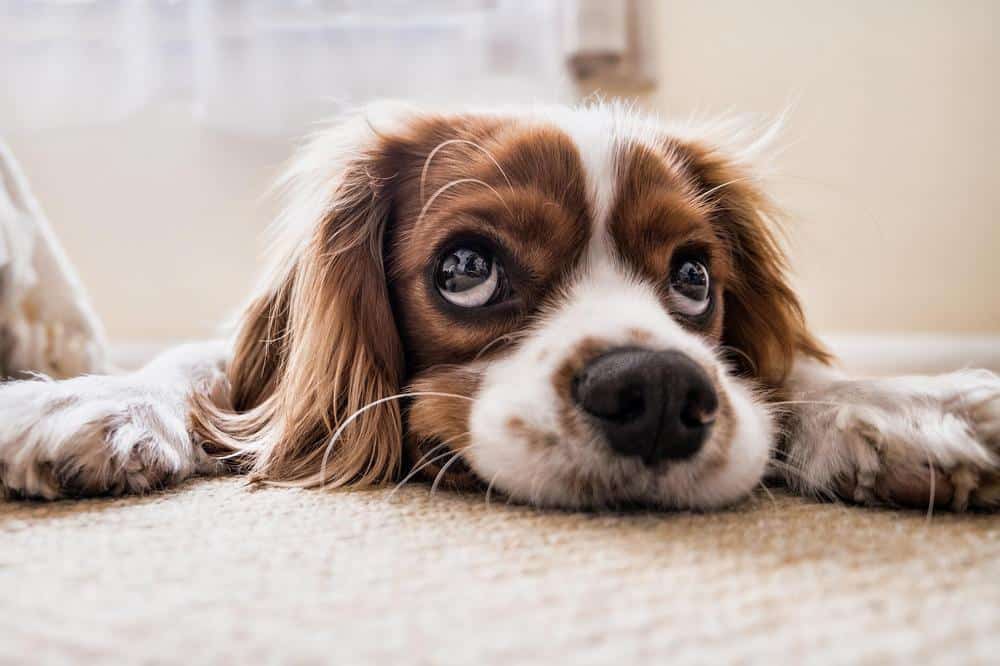
Also, I have a four-year-old that loves to scream and shout, so it made sense to keep my chinchilla in the basement where this won’t startle her. Startling a chinchilla can cause fur slips and anxiety which is clearly not advisable.
Choose a room that can fit a cage that’s large enough for your chinchilla.
Ensure the room has proper temperatures, but that it is also somewhat isolated from the rest of the house for most of the time. This is so they can sleep when they choose and not be startled by loud noises, kids, or other pets inside the home.
Lastly on our list are the essentials inside the chinchilla cage, which includes the simple things your chinchilla may enjoy playing with. Let’s jump into those details.
#7: Find The Perfect Blend Between Toys And Essentials In The Cage
So, we now have the size discussed and understood. We know the temperature, location, and essential items in the cage, but we also need to realize that the shelves by themselves just aren’t enough.
Chinchillas also need other items, such as hanging wooden toys that are chinchilla safe.
You see, chinchillas have rat-like teeth and need the ability to chew on various safe items. This avoids issues like teeth grinding, or other common problems, that can cause significant health issues with your chinchilla.
So, how do you keep a chinchilla’s teeth healthy?
Take advantage of the large cage and hang wooden toys and place wooden chew sticks throughout. Additionally, use items lke hay cubes to allow your chinchilla to play with and chew on.
These items are just as important as the other items we have discussed thus far into this post.
A last but not as often advised option for a chew item in your chinchilla’s cage could be cardboard. But I think it’s best to only let your chinchilla chew and eat cardboard with supervision and not when you are not around.
However, I do know plenty of chinchilla owners that have never had issues with this and give their chinchillas cardboard regularly.
Ultimately, that choice is yours. The important thing is that you understand that some chewable items need to be present inside of your chinchilla’s cage.
Chinchillas Also Need Time Out Of The Cage
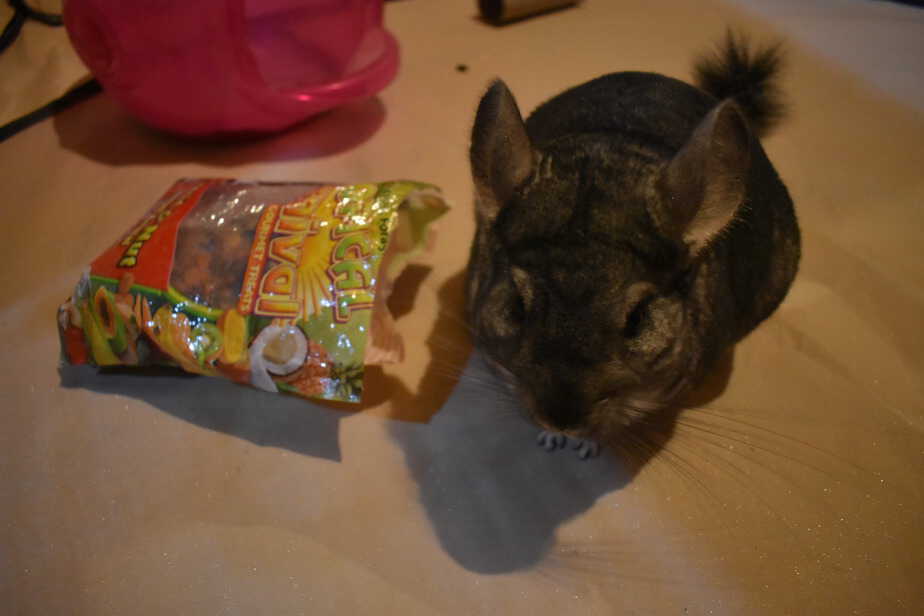
The last thing that I want to point out before sending you on your way is that nothing replaces the time your chinchilla spends with you. Chinchillas are friendly animals that enjoy human and other chinchilla interaction.
A bond can be built, and it’s crucial to make time for your chinchilla each day.
Some chinchillas are cuddlier then other chinchillas, but at the end of the day, it’s the time you spend with them that makes the most significant difference.
No matter how big of a chinchilla cage you buy for your pet, you can not neglect daily quality time together outside the cage. Make it at least 30 minutes, but ideally one hour.
Chinchilla Cage Size: Final Thoughts
A chinchilla cage should be as big as your living space will allow, but no smaller than the 3 by 2 by 2 foot recommendation we mentioned at the beginning of this post.
The 7 tips we laid out for you after that were simply a bonus to help you along the way.
Ensuring you implement these 7 tips and provide your chinchilla with what I have laid out in this post will keep your pet happy, healthy, and thriving for the next 15-20 years.
Doing so ensures that the answer to the question “Is it cruel to keep a chinchilla?” is a resounding “no!”.
I can promise you that.
Outside of that, the sky is the limit, and the choices are up to you. Chili and I wish you the best of luck with your new chinchilla and the journey you have ahead of you.
I’d love your feedback on this topic as well.
How big do you believe a chinchilla cage should be?
What’s the current cage that you are using for your chinchilla?
Be sure to share those thoughts, stories, and concerns by dropping a comment below.
As always, Chili and I appreciate you stopping by and reading today and we will see you again next time!

Tam says
I am debating between two cages. For a two month old chinchilla. One is 80cm high x 60 width x 40cm . The other cage is two stories. 116cm high x 94 cm width x 59cm. They are completely different. First cage is a wooden. With some Iron mesh. The other is a wired cage. I do plan on interacting with my Chinchilla twice a day for two hours. I have the time. Is bigger always better?
Josh says
Even if your chin is out of the cage 2 hours a day, it is still in the cage for the remaining 22 hours. That is a lot of time in there. If it were me, I’d definitely appreciate the extra size and I bet our pets do, too.
That said, even the first option is a good size. If you’re leaning toward that one, your chin won’t suffer.